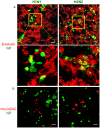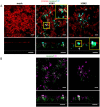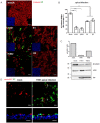The differentiated airway epithelium infected by influenza viruses maintains the barrier function despite a dramatic loss of ciliated cells
- PMID: 28004801
- PMCID: PMC5177954
- DOI: 10.1038/srep39668
The differentiated airway epithelium infected by influenza viruses maintains the barrier function despite a dramatic loss of ciliated cells
Abstract
Virus-host interactions in the respiratory epithelium during long term influenza virus infection are not well characterized. Therefore, we developed an air-liquid interface culture system for differentiated porcine respiratory epithelial cells to study the effect of virus-induced cellular damage. In our well-differentiated cells, α2,6-linked sialic acid is predominantly expressed on the apical surface and the basal cells mainly express α2,3-linked sialic acid. During the whole infection period, release of infectious virus was maintained at a high titre for more than seven days. The infected epithelial cells were subject to apoptosis resulting in the loss of ciliated cells together with a thinner thickness. Nevertheless, the airway epithelium maintained trans-epithelial electrical resistance and retained its barrier function. The loss of ciliated cells was compensated by the cells which contained the KRT5 basal cell marker but were not yet differentiated into ciliated cells. These specialized cells showed an increase of α2,3-linked sialic acid on the apical surface. In sum, our results help to explain the localized infection of the airway epithelium by influenza viruses. The impairment of mucociliary clearance in the epithelial cells provides an explanation why prior viral infection renders the host more susceptible to secondary co-infection by another pathogen.
Figures









Similar articles
-
Tropism and Infectivity of a Seasonal A(H1N1) and a Highly Pathogenic Avian A(H5N1) Influenza Virus in Primary Differentiated Ferret Nasal Epithelial Cell Cultures.J Virol. 2019 May 1;93(10):e00080-19. doi: 10.1128/JVI.00080-19. Print 2019 May 15. J Virol. 2019. PMID: 30814288 Free PMC article.
-
Tropism and infectivity of influenza virus, including highly pathogenic avian H5N1 virus, in ferret tracheal differentiated primary epithelial cell cultures.J Virol. 2013 Mar;87(5):2597-607. doi: 10.1128/JVI.02885-12. Epub 2012 Dec 19. J Virol. 2013. PMID: 23255802 Free PMC article.
-
Influenza A virus infection of primary differentiated airway epithelial cell cultures derived from Syrian golden hamsters.Virology. 2006 Oct 10;354(1):80-90. doi: 10.1016/j.virol.2006.06.024. Epub 2006 Jul 31. Virology. 2006. PMID: 16876846 Free PMC article.
-
An overview of influenza A virus receptors.Crit Rev Microbiol. 2011 May;37(2):157-65. doi: 10.3109/1040841X.2010.536523. Epub 2011 Mar 26. Crit Rev Microbiol. 2011. PMID: 21438845 Review.
-
Interplay between respiratory viruses and cilia in the airways.Eur Respir Rev. 2025 Mar 19;34(175):240224. doi: 10.1183/16000617.0224-2024. Print 2025 Jan. Eur Respir Rev. 2025. PMID: 40107662 Free PMC article. Review.
Cited by
-
Nucleic Acid-Based Sensing Techniques for Diagnostics and Surveillance of Influenza.Biosensors (Basel). 2021 Feb 12;11(2):47. doi: 10.3390/bios11020047. Biosensors (Basel). 2021. PMID: 33673035 Free PMC article. Review.
-
Infection Studies with Airway Organoids from Carollia perspicillata Indicate That the Respiratory Epithelium Is Not a Barrier for Interspecies Transmission of Influenza Viruses.Microbiol Spectr. 2023 Mar 14;11(2):e0309822. doi: 10.1128/spectrum.03098-22. Online ahead of print. Microbiol Spectr. 2023. PMID: 36916937 Free PMC article.
-
Polarization of protease-activated receptor 2 (PAR-2) signaling is altered during airway epithelial remodeling and deciliation.J Biol Chem. 2020 May 8;295(19):6721-6740. doi: 10.1074/jbc.RA120.012710. Epub 2020 Apr 2. J Biol Chem. 2020. PMID: 32241907 Free PMC article.
-
Avian Influenza A Virus Infects Swine Airway Epithelial Cells without Prior Adaptation.Viruses. 2020 May 28;12(6):589. doi: 10.3390/v12060589. Viruses. 2020. PMID: 32481674 Free PMC article.
-
Viral Coinfection Replaces Effects of Suilysin on Streptococcus suis Adherence to and Invasion of Respiratory Epithelial Cells Grown under Air-Liquid Interface Conditions.Infect Immun. 2019 Jul 23;87(8):e00350-19. doi: 10.1128/IAI.00350-19. Print 2019 Aug. Infect Immun. 2019. PMID: 31138613 Free PMC article.
References
Publication types
MeSH terms
Substances
LinkOut - more resources
Full Text Sources
Other Literature Sources
Research Materials
Miscellaneous

